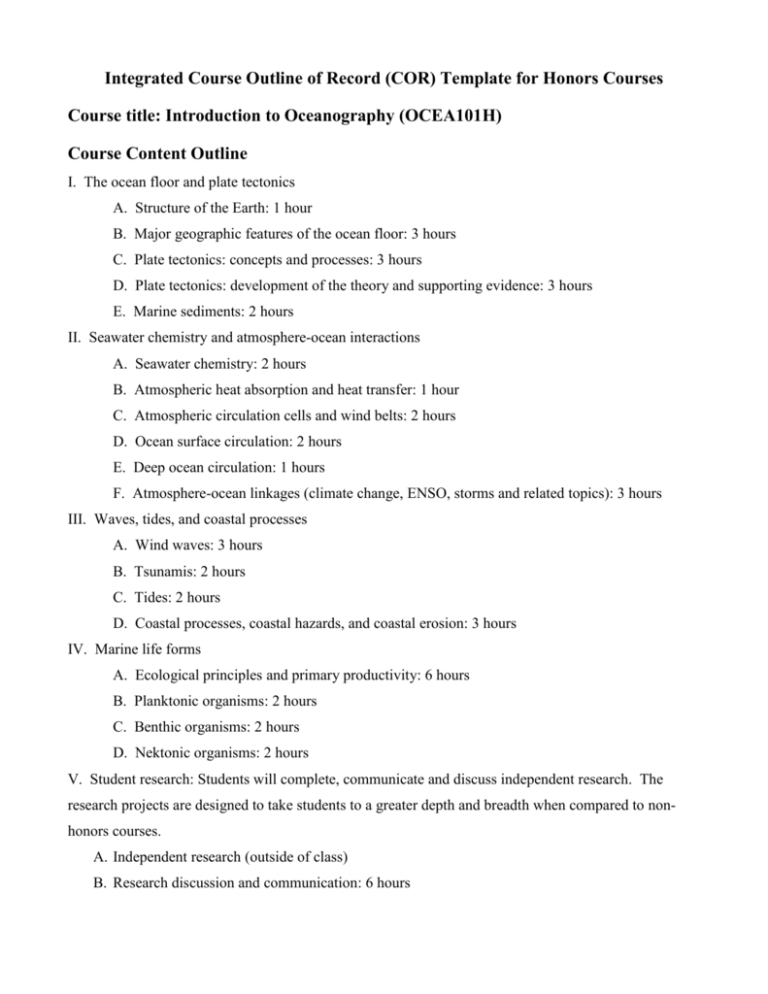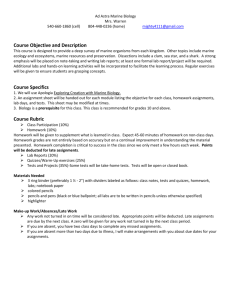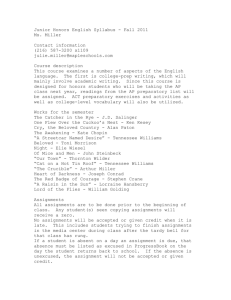
Integrated Course Outline of Record (COR) Template for Honors Courses
Course title: Introduction to Oceanography (OCEA101H)
Course Content Outline
I. The ocean floor and plate tectonics
A. Structure of the Earth: 1 hour
B. Major geographic features of the ocean floor: 3 hours
C. Plate tectonics: concepts and processes: 3 hours
D. Plate tectonics: development of the theory and supporting evidence: 3 hours
E. Marine sediments: 2 hours
II. Seawater chemistry and atmosphere-ocean interactions
A. Seawater chemistry: 2 hours
B. Atmospheric heat absorption and heat transfer: 1 hour
C. Atmospheric circulation cells and wind belts: 2 hours
D. Ocean surface circulation: 2 hours
E. Deep ocean circulation: 1 hours
F. Atmosphere-ocean linkages (climate change, ENSO, storms and related topics): 3 hours
III. Waves, tides, and coastal processes
A. Wind waves: 3 hours
B. Tsunamis: 2 hours
C. Tides: 2 hours
D. Coastal processes, coastal hazards, and coastal erosion: 3 hours
IV. Marine life forms
A. Ecological principles and primary productivity: 6 hours
B. Planktonic organisms: 2 hours
C. Benthic organisms: 2 hours
D. Nektonic organisms: 2 hours
V. Student research: Students will complete, communicate and discuss independent research. The
research projects are designed to take students to a greater depth and breadth when compared to nonhonors courses.
A. Independent research (outside of class)
B. Research discussion and communication: 6 hours
Student Performance Objectives
Upon successful completion of this course, students will be able to do the following:
1. Differentiate the layered structure of the earth, and evaluate how plate tectonic processes have
created the major features of the ocean floor.
2. Evaluate the effects of physical and chemical changes on seawater's properties and behavior.
3. Reconstruct the general circulation of the atmosphere, surface ocean currents, and deep ocean
currents, and analyze their interrelationships.
4. Describe the major principles involved in the formation and behavior of waves and tides, and evaluate
their effects on coastal processes.
5. Identify major types of marine life, and the factors that control primary productivity.
6. Evaluate how physical properties of the ocean affect marine communities and marine life.
7. Students in the honors section are expected to demonstrate the ability to independently evaluate
published scientific material using knowledge gained from the course, and to form hypotheses and
conclusions based upon these data. The course requires students to produce scholarly work, including
proper form for written scientific materials and oral communication of scientific conclusions and data.
Reading Assignments
Reading assignments are required and may include, but will not be limited to, the following:
1). Read about oceanographic concepts in the class text and note the introduction and use of specialized
terms, concepts, and theories.
2). Evaluate and summarize oceanographic information in scientific articles and/or websites assigned by
the instructor and/or chosen by the student.
3). Honors students have more opportunities for independent reading, and reading assignments require a
higher level of critical thinking, than in a non-honors course. Students are expected to demonstrate the
ability to independently evaluate published scientific material using knowledge gained from the course;
and form hypotheses and conclusions based upon these data.
Writing Assignments
Writing assignments are required and may include, but will not be limited to, the following:
1). Research sources and write a scholarly paper and other out-of-class writing assignments on selected
oceanographic topics.
2). Complete written assignments in class, either as parts of exams or as parts of in-class exercises.
3). Honors students are expected to demonstrate the ability to communicate conclusions and hypotheses
reached from independent research clearly and succinctly in a proper scientific form. Honors students
complete more writing, and the writing assignments require a higher level of critical thinking, than in a
non-honors course.
Outside-of-class Assignments
Outside-of-class assignments are required and may include, but will not be limited to, the following:
1). Complete homework assignments (writing assignments, quizzes, and related work) assigned by the
instructor.
2). Research sources for a scholarly paper and other written assignments, as assigned by the instructor.
3). Read assigned chapters in the course text.
4). Review and study class notes in preparation for exams and quizzes.
5). Honors students will conduct substantial research outside of class to prepare a scholarly paper and a
class presentation. Students are expected to demonstrate the ability to independently evaluate published
scientific material, and to form hypotheses and conclusions based upon scientific data.
Catalog description
This course offers highly motivated students an enriched introduction to the scientific study of the
oceans. The course explores the major processes and features of the world's oceans, including plate
tectonics, the origin and history of the ocean basins, atmospheric circulation, weather and climate, ocean
circulation, and the dynamics of waves, tides, and coastlines. The course also reviews marine life
(including plankton, nekton, benthos, and marine mammals), explores the oceans as a resource for
people, and considers human impacts on marine environments.
Schedule description
This course offers highly motivated students an enriched introduction to the scientific study of the
oceans. Topics include the formation and evolution of the ocean basins, atmosphere-ocean interactions,
waves, tides, coastal oceanography, and an introduction to the study of marine life, including plankton,
fishes, and marine mammals.
Methods of Instruction
Instructional methodologies will be consistent with, but will not be limited to, the following types or
examples:
1). Presentation of concepts and scientific information by the instructor in a variety of modalities
suitable for achieving the student learning objectives. These modalities may include lecture, use of
blackboard/whiteboard, demonstrations, Powerpoint presentations, topic outlines, internet resources,
videos, animations, and/or other multimedia resources as needed.
2). Active learning by students in the form of question-answer, class discussion, in-classroom and/or
out-of-classroom exercises to test and reinforce oceanographic concepts.
3). Research by students using appropriate published and/or internet sources to complete a term paper
and/or other writing assignments.
Note: This honors course requires a greater degree of student participation, engagement, and interaction,
and has greater flexibility in format and teaching methodologies, than a non-honors course.
Methods of Evaluation
Evaluation methodologies will be consistent with, but will not be limited to, the following types or
examples:
1). Evaluation of exams and quizzes that test the student’s knowledge of oceanographic concepts and
terminology.
2). Evaluation of the scope, accuracy and content of written work (term paper and/or written homework
assignments and/or in-class writing assignments).
4). Evaluation of class participation and contributions to class discussion.
5). Evidence of critical thinking on exams, writing assignments, and/or class discussion.
Note: Student work is evaluated with higher standards of performance expectation, including the
breadth, depth and rigor demonstrated by research on a scholarly paper and an associated class
presentation.
Required Materials
Examples of typical college-level textbooks or other print materials for this degree-applicable course
include the following:
Trujillo, A. and H. Thurman, 2008. Essentials of Oceanography, 9th edition. Pearson / Prentice Hall.
ISBN: 9780132401227
Garrison, T., 2006. Oceanography: An Invitation to Marine Science, 6th edition. Brooks Cole. ISBN:
978-0495112860
Student Learning Outcomes
1. Explain the theory of plate tectonics and relate it to the formation of major sea floor features.
2. Reconstruct the circulation patterns of atmosphere and ocean circulation systems, and analyze their
interrelationships.
3. Describe the major principles involved in the formation and behavior of waves and tides, and evaluate
their effects on coastal processes.
4. Summarize the major physical properties of the oceans and evaluate how each one affects marine
communities and marine life.









